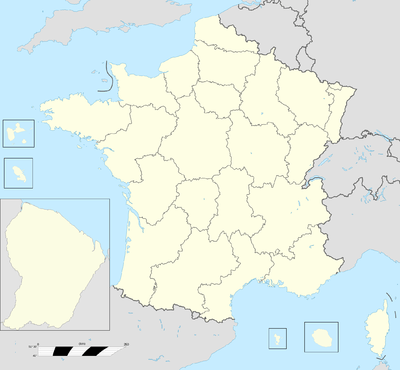Regions of France
| Region Région (French) | |
|---|---|
 | |
| Category | Unitary State |
| Location | French Republic |
| Number | 27 |
| Possible status |
Overseas region (5) Région d'outre-mer |
| Additional status |
Territorial collectivity Collectivité Territoriale |
| Populations | 229,040 (French Guiana) – 11,786,234 (Île-de-France) |
| Areas | 436 square miles (1,130 km2) (Martinique) – 32,253 square miles (83,530 km2) (French Guiana) |
| Government | Region Government, National Government |
| Subdivisions | Department |
|
This article is part of the series on
Administrative divisions of France |
|
(incl. overseas regions) |
|
(incl. overseas departments) |
|
Urban communities |
|
Others in Overseas France
Overseas collectivities |
France is divided into 27 administrative regions (French: région, [ʁe.ʒjɔ̃]), 22 of which are in Metropolitan France, and five of which are overseas. Corsica is a territorial collectivity (French collectivité territoriale), but is considered a region in mainstream usage, and is even shown as such on the INSEE website.[1] The mainland regions and Corsica are each further subdivided into departments, ranging in number from 2 to 8 per region for the metropolitan regions; the overseas regions technically consist of only one department each. The term region was officially created by the Law of Decentralisation (2 March 1982), which also gave regions their legal status. The first direct elections for regional representatives took place on 16 March 1986.[2]
General characteristics
In mainland France (excluding Corsica), the median land area of a region is 25,809 km² (9,965 sq mi), which is slightly larger than the U.S. state of Vermont, 4% of the median land area of a Canadian province, or 15% larger than the median land area of a German Regierungsbezirk.
In 2004, the median population of a region in continental France was 2,329,000 inhabitants, three quarters of the median population of a German Land (state), but more than twice the median population of a Canadian province.

Role
Regions lack separate legislative authority and therefore cannot write their own statutory law. They levy their own taxes and, in return, receive a decreasing part of their budget from the central government, which gives them a portion of the taxes it levies. They also have considerable budgets managed by a regional council (conseil régional) made up of representatives voted into office in regional elections.
A region's primary responsibility is to build and furnish high schools. In March 2004, the French central government unveiled a controversial plan to transfer regulation of certain categories of non-teaching school staff to the regional authorities. Critics of this plan contended that tax revenue was insufficient to pay for the resulting costs, and that such measures would increase regional inequalities.
In addition, regions have considerable discretionary power over infrastructural spending, e.g., education, public transit, universities and research, and assistance to business owners. This has meant that the heads of wealthy regions such as Île-de-France or Rhône-Alpes can be high-profile positions.
Proposals to give regions limited legislative autonomy have met with considerable resistance; others propose transferring certain powers from the departments to their respective regions, leaving the former with limited authority.
Regional control
Number of regions controlled by each coalition since 1986.

Regions and their capitals
Arms of the regions of France[5]

Reform and mergers of regions

In 2014, the French Parliament (the National Assembly and the Senate) passed a law that will reduce the number of regions in Metropolitan France from 22 to 13. The new regions will take effect on 1 January 2016.[6]
Regions to merge:
Regions that will remain unchanged:
| Brittany | |
| Centre-Val de Loire | |
| Corsica | |
| Île-de-France | |
| Pays de la Loire | |
| Provence-Alpes-Côte d'Azur |
The text of the law gives interim names for most of the new regions by combining the names of the existing regions, e.g. the region composed of Aquitaine, Poitou-Charentes and Limousin is Aquitaine-Limousin-Poitou-Charentes. However, the combined region of Upper and Lower Normandy is simply called "Normandy" (Normandie). Permanent names will be proposed by the new regional councils and confirmed by the Conseil d'Etat by 1 July 2016.[7] The legislation defining the new regions also allowed the Centre region to officially change its name to "Centre-Val de Loire"; this change was effective from January 2015.[8]
Previous proposals
-
_map.svg.png)
Édouard Balladur's proposal
-
_map.svg.png)
Manuel Valls's proposal A
-
_map2.svg.png)
Manuel Valls's proposal B
-
_map3.svg.png)
President François Hollande's proposal
See also
- Ranked list of French regions
- List of French regions and overseas collectivities by GDP
- Flags of the regions of France
- ISO 3166-2:FR
General:
- Décentralisation
- Budget of France
- Regional councils of France
- Administrative divisions of France
References
- ↑ 1.0 1.1 "Carte des Régions" (in French). INSEE. Retrieved 2009-09-29.
- ↑ Jean-Marie Miossec (2009), Géohistoire de la régionalisation en France, Paris: Presses universitaires de France ISBN 978-2-13-056665-6.
- ↑ These flags are not official.
- ↑ New name as of 17 January 2015; formerly named Centre.
- ↑ For most of the regions, these arms are not official.
- ↑ La carte à 13 régions définitivement adoptée, Le Monde, 17 December 2014, accessed 2 January 2015
- ↑ Quel nom pour la nouvelle région ? Vous avez choisi..., Sud-Ouest, 4 December 2014, accessed 2 January 2015
- ↑ "Journal officiel of 17 January 2015". Légifrance (in French). 2015-01-17. Retrieved 2015-03-10.
External links
- (English) Regions of France at DMOZ
- Guide to the regions of France
- Local websites by region
- Useful information on France
- Will 2010 regional elections lead to political shake-up? Radio France Internationale in English
| ||||||||||||||
| ||||||||||||||||||